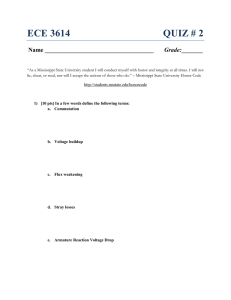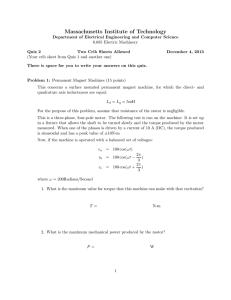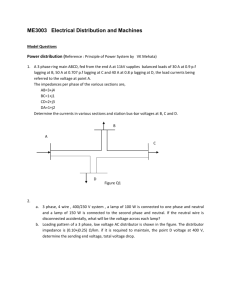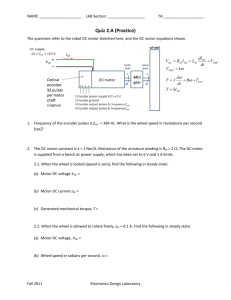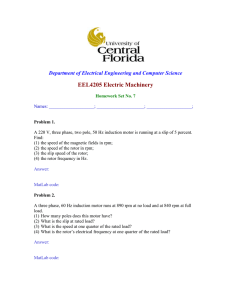Electrical Machinery Analysis
advertisement
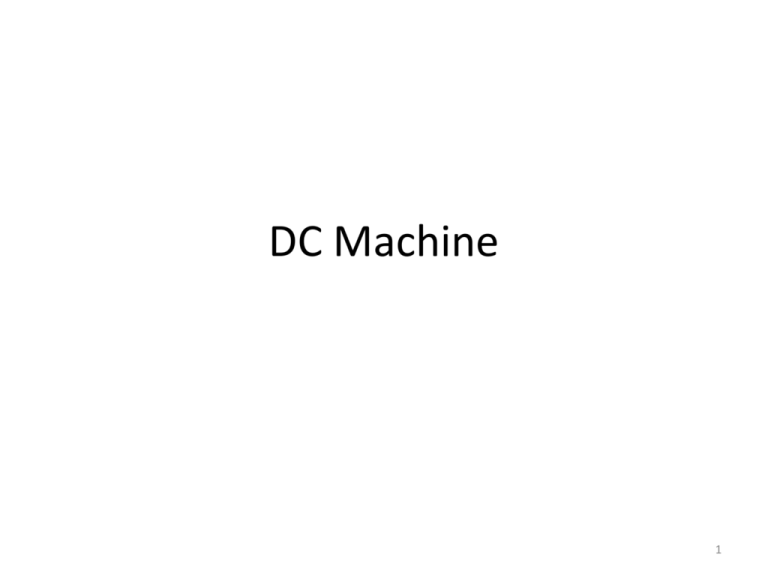
DC Machine 1 Content • • • • • Introduction Elementary DC machine Voltage and Torque Equations Basic Type DC Machines Dynamics characteristics of Magnet Permanent and Shunt DC Motor 2 Introduction • DC machines application not widely used • DC generator is replaced by rectifier • DC Motor is still used in lower power : – Shunt DC Motor – Permanent Magnet DC Motor • Brushless DC motor becomes popular and widely used in electric vehicle. 3 Elementary of DC Machine • Stator coil as field winding source of flux • Rotor coil as armature 4 Voltage Equation Voltage equation for field winding and rotor coil Flux linkage : Mutual inductance winding between field winding and armature as a function of Θr : Θr = 0, π, 2 π, ........ L= Constant 5 Open circuit voltage 6 DC Machine with paralel winding in out A and a rotor coil 7 Comutation of DC Machine with permanent magnet • Constant flux is established by magnet permanent • Small dc motor with low power control application 8 Voltage Equation • Voltage field and coil winding is rotor speed is referred as back emf 9 Torque Equation • Electromagnetic torque • Torque and rotor speed equation : J = inertia of the rotor (kg m2 or Js2 ) TL = mechanical load Bm = mechanical damping ratio (Nms) Te is positive in direction of θr and direction of TL opposes of Te 10 Basic Type of DC Machine (1) • Separate Winding • Shunt DC Machine 11 Shunt Characteristic 12 Basic Type of DC Machine (2) • Series Winding • Application : traction motor for train or bus, hoists and crane • High starting torque with mechanical load at normal operation 13 Series Characteristic Torque and speed characteristics 14 Dynamic characteristics of permanent magnet and Shunt DC Machine • Two modes of dynamic operation are of interesting : – Starting from stall – Changing in mechanical load Constant voltage source 15 Starting characteristics of permanent magnet DC motor Direct on line starting for small power, Current starting limitation in large hp motor 16 Dynamic performance during sudden changes in load torque. DC motor 5 hp , 240 V, 127,7 rpm load 1 kg m2 DC motor 200 hp, 250 V, 600 rpm 17 Time Block Diagram and State Equation • Shunt DC motor Solving field voltage equation and armature voltage equation: 18 Solving for dωr /dt : State equation in matrix (vector matrix) : 19 • Permanent Magnet DC Motor 20 System Equation : x = state vector u = input vector 21 • Example For control Design to express transfer functions between state and input variables. • To derive transfer function between state variables (ia and ωr) and input variables (ia and TL). Inertia time constant Second order differential equation in term of ωr: Coefficient of dumping ratio 22 Finally , 23 DC shunt Motor Constant Torque Parameter : Vt (rated)= 120 V ; Ia (rated) = 10 A ; n = 1200 rpm ; If = 1,6 A Ra = 0.5 Ω La = 0.01H Typical loads include belt conveyors with a Rf = 75 Ω Lf = 0.02 H fixed loading, extruders, hoists, and mine lifts. Mechanical Load = 50 N 24 Ia 250 200 150 100 50 0 n 1000 800 600 400 200 0 -200 Tem_DC4 200 150 100 50 0 0 0.2 0.4 0.6 0.8 1 Time (s) 25 Laplace Transform Parameter dc permanent magnet : 6 V, ra = 7 Ω, LAA = 120 mH kT = 2 oz.in/A, J = 150 µoz.in.s2 . No load rpm = 3350 rpm I no load = 0,15 A 26 27 For step voltage Inverse Laplace 28 Using euler equation : Substituting parameter : 29 PR • • • • 1-5 6-10 11-15 16-19 ( Urut 1 - 20 ) ( Urut 21 – 40) ( Urut 41 – 60) (Urut 61 – 80) 30 Electrical Motor Development • • • • • • Basic Priciples of Electrical Machine Analysis DC Machine Reference Frame Theory Induction Machine Synchronous Machine BLDC Machine 31

